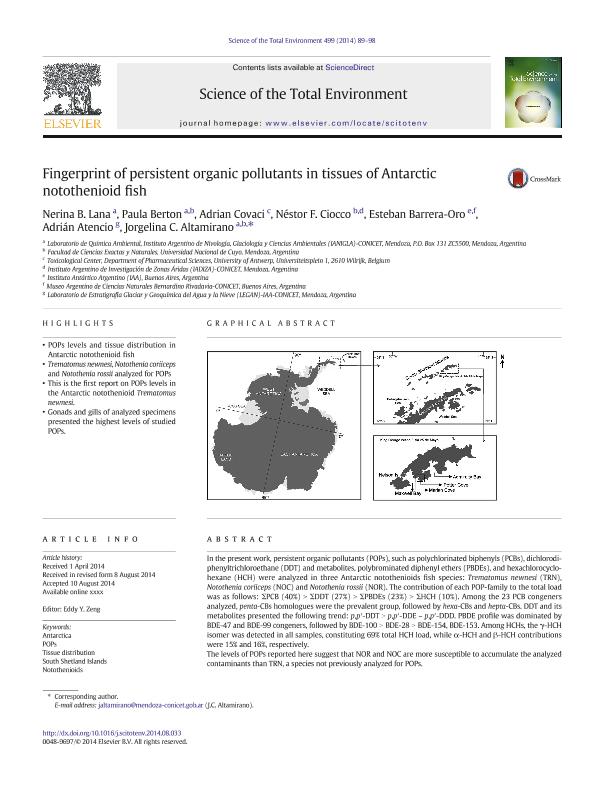Artículo
Fingerprint of persistent organic pollutants in tissues of Antarctic notothenioid fish specimens
Lana, Nerina Belén ; Berton, P.; Covaci, Adrián; Ciocco, Nestor Fernando
; Berton, P.; Covaci, Adrián; Ciocco, Nestor Fernando ; Barrera Oro, Esteban
; Barrera Oro, Esteban ; Atencio, Adrian Gonzalo
; Atencio, Adrian Gonzalo ; Altamirano, Jorgelina Cecilia
; Altamirano, Jorgelina Cecilia
 ; Berton, P.; Covaci, Adrián; Ciocco, Nestor Fernando
; Berton, P.; Covaci, Adrián; Ciocco, Nestor Fernando ; Barrera Oro, Esteban
; Barrera Oro, Esteban ; Atencio, Adrian Gonzalo
; Atencio, Adrian Gonzalo ; Altamirano, Jorgelina Cecilia
; Altamirano, Jorgelina Cecilia
Fecha de publicación:
08/2014
Editorial:
Elsevier Science
Revista:
Science of the Total Environment
ISSN:
0048-9697
Idioma:
Inglés
Tipo de recurso:
Artículo publicado
Clasificación temática:
Resumen
In the present work, persistent organic pollutants (POPs), such as polychlorinated biphenyls (PCBs), dichlorodiphenyltrichloroethane (DDT) and metabolites, polybrominated diphenyl ethers (PBDEs), and hexachlorocyclohexane (HCH) were analyzed in three Antarctic notothenioids fish species: Trematomus newnesi (TRN), Notothenia coriiceps (NOC) and Notothenia rossii (NOR). The contribution of each POP-family to the total load was as follows: PCB (40%) >DDT (27%) >PBDEs (23%) >HCH (10%). Among the 23 PCB congeners analyzed, penta-CBs homologues were the prevalent group, followed by hexa-CBs and hepta-CBs. DDT and its metabolites presented the following trend: p,p?-DDT >p,p?-DDE ~ p,p?-DDD. PBDE profile was dominated by BDE-47 and BDE-99 congeners, followed by BDE-100 > BDE-28 > BDE-154, BDE-153. Among HCHs, the γ-HCH isomer was detected in all samples, constituting 69% total HCH load, while α-HCH and β-HCH contributions were 15% and 16%, respectively. The levels of POPs reported here suggest that NOR and NOC are more susceptible to accumulate the analyzed contaminants than TRN, a specie not previously not analyzed for POPs. Distribution of POPs among different tissues of the three species (muscle, liver, gonads, and gills) was also investigated. Considering lipid weight, the general pattern of POPs distribution in tissues indicated that while gonads showed higher levels of PCBs, DDTs and HCH, the most significant PBDE concentrations were recorded in gills. Also, a comparative analysis of POPs concentration in fish samples from Antarctic area was included.
Palabras clave:
ANTARCTICA
,
POPS
,
TISSUE DISTRIBUTION
,
SOUTH SHETLAND ISLANDS
Archivos asociados
Licencia
Identificadores
Colecciones
Articulos(IADIZA)
Articulos de INST. ARG DE INVEST. DE LAS ZONAS ARIDAS
Articulos de INST. ARG DE INVEST. DE LAS ZONAS ARIDAS
Articulos(IANIGLA)
Articulos de INST. ARG. DE NIVOLOGIA, GLACIOLOGIA Y CS. AMBIENT
Articulos de INST. ARG. DE NIVOLOGIA, GLACIOLOGIA Y CS. AMBIENT
Articulos(SEDE CENTRAL)
Articulos de SEDE CENTRAL
Articulos de SEDE CENTRAL
Citación
Lana, Nerina Belén; Berton, P.; Covaci, Adrián; Ciocco, Nestor Fernando; Barrera Oro, Esteban; et al.; Fingerprint of persistent organic pollutants in tissues of Antarctic notothenioid fish specimens; Elsevier Science; Science of the Total Environment; 499; 8-2014; 89-98
Compartir
Altmétricas



